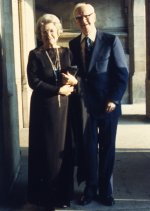
In the middle thirties, Dr. Houdry introduced into this country a process for catalytically cracking petroleum fractions to gasoline. An intensive catalyst development program was undertaken by the oil companies and resulted in the use of activated clays and silica-alumina amorphous catalysts for the cracking process. On joining the multiple petroleum fellowship at Mellon in late 1944, I decided to undertake some work on catalytic cracking and I decided to make use of our new tool, carbon-14, as a tracer in learning more about the cracking reaction and catalyst.
On reviewing the literature, two problems seemed to suggest themselves for study. First of all, it was apparent that nobody had succeeded in measuring the chemisorption of the reactants (cracking oil or other saturated hydrocarbons) on the cracking catalysts then in use. It had become axiomatic that at least one of any combination of reactants had to be chemisorbed on the catalyst in a catalytic process. Preliminary work showed that ordinary volumetric measurement of the chemisorbed gas was not sufficiently sensitive to detect the chemisorption that we felt must exist. So we turned to the use of radioactive hydrocarbons. We found, for example, that we could get a sensitivity in studying the adsorption of radioactive butane of about a microgram per gram of catalyst. The chemisorption of normal butane turned out to be about 0.003 cc per gram at a few hundred degrees centigrade and one atmosphere pressure so it was easily measured by the radioactive method. The mystery of the low chemisorption turned out to be the very small size of the fraction of the catalyst surface that constituted the active catalytic sites.
The other point of attack was the getting of information concerning secondary reactions that were involved in forming the final cracking products. For example it was established that the addition of 1% radioactive propylene to a stream of cetane being passed over a cracking catalyst would result in the formation of radioactive C4 to C10 products, including olefins, paraffins, and aromatics. In accordance with theories that had been formulated ethylene should not and did not behave like propylene. Except for a small conversion to ethane it did not appear in any of the cracking products of cetane. It even became possible in this tracer work to show the source of many of the cracking products. For example it turned out that most of the aromatics formed in cracking cetane are formed from the polymerization of low molecular weight olefins. This work was started at the Mellon Institute but continued at The Johns Hopkins University from 1955 to 1970 when I retired. A number of papers were published but four or five papers covering interesting aspects of the work are still to be published. Publication becomes a slow process when one is foolish enough, as I have been, to let the student delay his writeup of papers for publication until he gets a job in industry or elsewhere that takes up most of his time. Again the contribution of this research has been of a basic nature and has not led directly to the production of better cracking catalysts.


